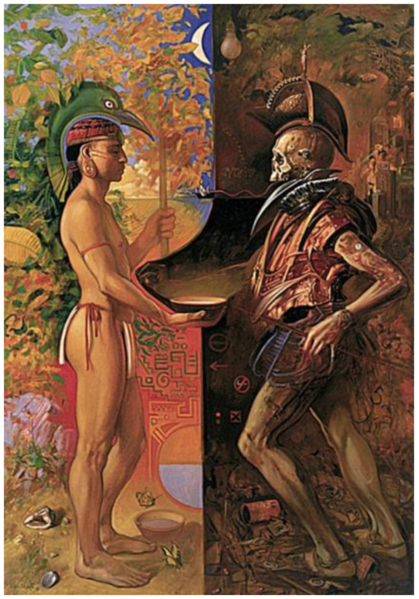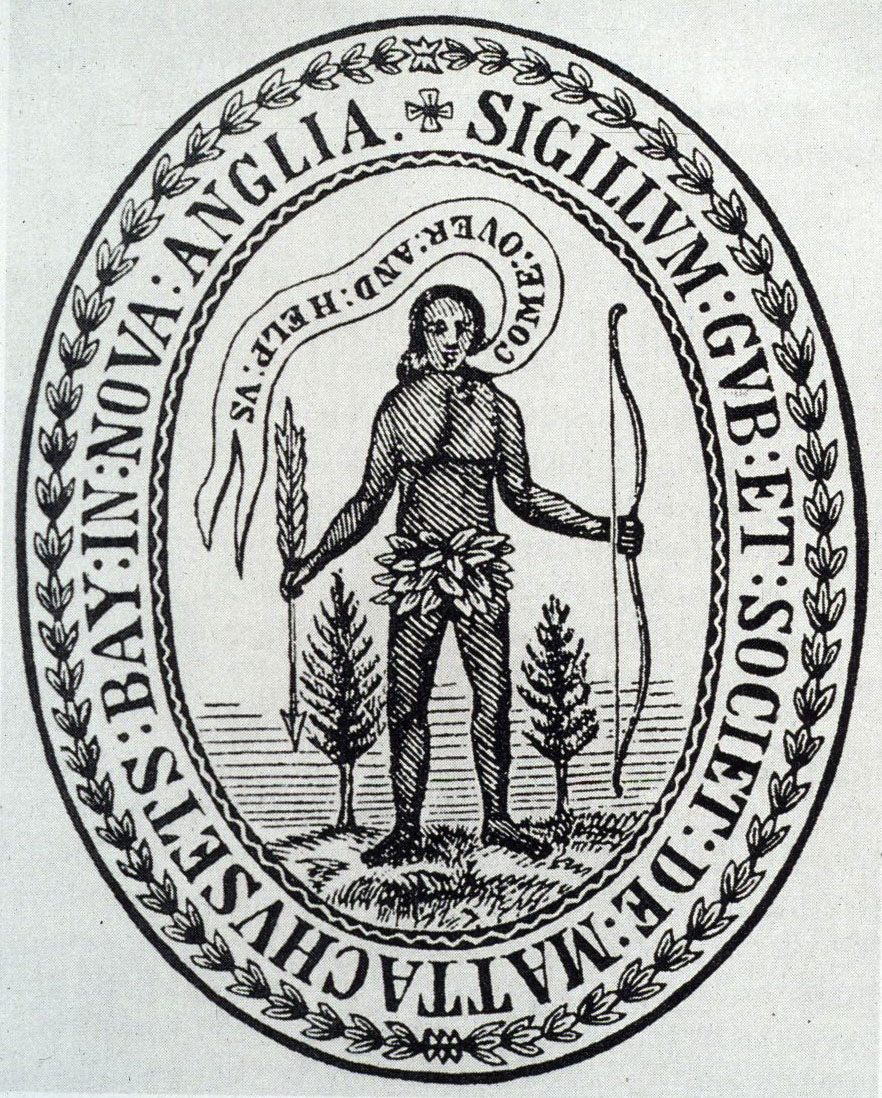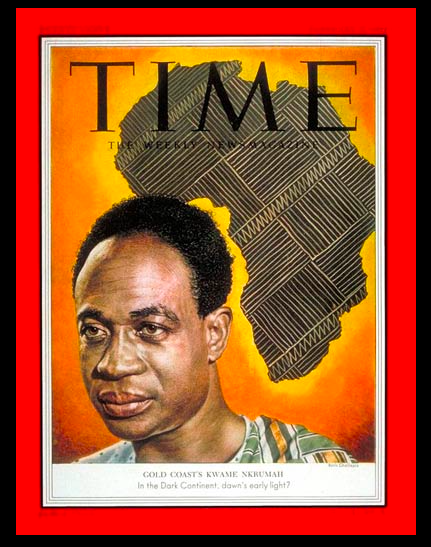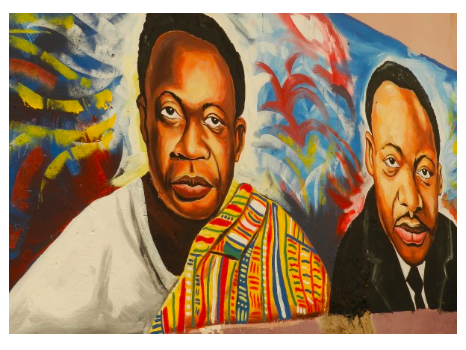4.2 Roots of Global Inequality

Figure 4.2. The painting titled, “Encuentro” (in English: The Meeting or The Encounter) by Jaime Zapata represents a meeting between an indigenous person and a conquistador (an early Spanish colonizer). The indigenous person is presented as living in good health, with an abundance of nature, offering a bowl to the conquistador. The conquistador is depicted with deathly imagery and examples of a destructive modern civilization.
4.2.1 Colonialism
The world today is deeply unequal. Why is that? What has led to the patterns of inequality that shape and divide this world? Why are some places and peoples so wealthy and others so poor?
There are no simple answers to questions that extensive. However, good answers would probably start with some history. The modern world, and the modern system of inequality, has grown in part out of the colonial system that governed much of the world over the past several centuries.
Colonialism refers to the policy of military, economic and ideological conquest of one society by another. Colonization is the action or process of settling among and establishing control over the indigenous people of an area.
Societies all over the world have engaged in various forms of colonialism over the past several thousand years. Over the past 500 years, European colonialism reordered the global map, often waging wars of physical and cultural genocide on people, from West Africa to the Pacific Northwest. So, if our question is about the roots of contemporary global inequality, our attention should focus a good deal on European colonialism. After all, it is not an accident that the wealthy countries in the world today are also former colonial powers, while most of the poor countries are former colonies.
4.2.1.1 Colonies of rule and settlement
European colonialism can be divided into two main forms. Colonies of Rule refer to colonies governed by a relatively small population of colonial administrators, usually for the purpose of extracting resources and wealth. England’s colonization of India would be considered a Colony of Rule.
Colonies of Settlement are colonies in which the colonial power sends a large number of its domestic population to settle the colony, thus displacing the indigenous population. The English colonies in North America offer one important example. Colonies of Settlement tend to be even more violent that Colonies of Rule, since they often involve the forced removal or mass murder of indigenous people. Figure 4.2 depicts how colonialism brought destruction to the indigenous world.
So how did colonialism create the patterns of wealth and inequality that make up our world today? As a political-economic system, colonialism enabled the colonial power to extract wealth from colonized societies, often in the form of agricultural products (like cotton, tobacco or sugar) or mineral resources (like gold, silver or oil.)
As such, colonialism simultaneously enriched the colonial elite and impoverished the colony by extracting wealth from the colony and concentrating it within the colonial power. Thus, it formed an economic relationship that resulted in the enrichment of one party by way of the impoverishment of the other. The wealth of the wealthy and the poverty of the poor are ultimately two sides of the same coin – two sides of a relationship of extraction (McMichael, 2017.)
To create these relations of economic extraction, colonial powers attacked and restructured the social and economic lives of colonized peoples. To establish new colonial economies, most aspects of indigenous life had to change. Local agriculture, with all of its cultural significance and nutritional complexity was often transformed into export oriented monocrop agriculture. Family and gender systems were often transformed, as European patriarchal traditions limited women’s access to land and other resources (Waylen, 1996) And colonial elites oversaw various assaults on indigenous language, culture and spirituality.
The United States government orchestrated a sustained campaign to destroy Native American cultures and identities. For a piece of this story, please watch this 13:41-minute video: “How the US stole thousands of Native American children” by Vox (Figure 4.3). As you watch, what are some reasons the US government attempted to dislocate native families and assimilate native children? What are some ways indigenous people survived and resisted these practices? What were some of the consequences for native people?
Figure 4.3. How the US stole thousands of Native American children [YouTube Video] by Vox
4.2.2 Ideologies of Colonialism
European colonialism involved genocide, enslavement, displacement and impoverishment. But like most systems of power, it was legitimized by a host of ideologies. “Ideology” refers to the collection of ideas that form a person’s worldview and which help them make sense of the society in which they live. Colonial ideologies made colonialism appear legitimate, inevitable and desirable in the minds of many of the people who carried it out.
The colonial powers almost universally presented their rule as a “civilizing force,” which would ultimately benefit colonized people. The Civilization Mission has been articulated in different ways in different times and places, but it invariably frames colonized people as backward and in need of some “superior” society to intervene to improve their lives. It is a mix of dominance and paternalism – presenting colonization as serving the best interests of colonized people.
Take, for example, the 1629 Massachusetts Bay Colony Seal (Figure 4.4). As a symbol of the recently established British colony, it depicts a native man, naked except for leaves over his groin, with a scroll emerging from his mouth that reads, “come over and help us.” The image depicts native people as living in an Edenic state of nature, in need of salvation and civilization.

Figure 4.4. Massachusetts Bay Colony Seal (1629)
While the civilizing mission has been deployed throughout all periods of European and US Colonialism, it has been articulated in different ways. By the late 19th century, it had become highly racialized. The British poet and author Rudyard Kipling coined it “The White Man’s Burden” in his 1899 poem by that name. It reads in part:
Take up the White Man’s burden—
Send forth the best ye breed—
Go bind your sons to exile
To serve your captives’ need;
To wait in heavy harness
On fluttered folk and wild—
Your new-caught, sullen peoples,
Half devil and half child.
The White Man’s Burden became popular as a framework for interpreting colonial expansion – framing colonized people as simultaneously childlike and dangerous, while framing agents of colonial power as stern and wise parents.
The social theorist Edward Said argued in his classic book Orientalism that European colonialism constructed and rested upon a certain view of the world (Said 1978) That worldview divided “The West” or “The Occident” from “The East” or “The Orient.” In doing so, it separated various cultural groups into these two broad categories, erasing their actual cultural complexities and histories and forging a clear sense of “us” and “them.” It also assigned each group certain characteristics. The so-called “West” represented the so-called “East” as, among other things, static, sensual, perverse, mystical and despotic. In doing so, the “West” represented themselves as the opposite: progressing, rational, moral, scientific and liberal. From Said’s perspective, colonialism rested on a discourse of power – a certain way of seeing and organizing the world. He called that discourse “Orientalism.”
For more on the ideologies of colonialism, you can check out the podcast, “The Walls Built in Our Minds,” that was introduced in Chapter 2.
4.2.3 Neocolonialism
When did the colonial period end? That question is more difficult to answer than it might seem.
Throughout the colonial period, colonized peoples organized innumerable campaigns of resistance, from indigenous uprisings, to slave revolts, to independence campaigns led by colonial settlers. The first successful expulsion of a colonial power was the Haitian Revolution. In 1791, formerly enslaved people in Haiti rebelled against their French colonial administrators and won formal independence 1804. However, the majority of colonies around the world did not gain their independence until much later.
World War Two (1939-1945) marked the beginning of the end of formal colonialism. In the period just following the war, anti-colonial forces successfully took advantage of the weakened state of the colonial powers. Independence movements spread around the world and former colonies became independent nation-states. So, one could argue that the colonial period ended in between the 1940s and 1960s.
However, many scholars suggest that the colonial period hasn’t ended at all, but only changed. Neocolonialism is a new form of colonialism in which the colonial powers maintain their economic and political dominance over former colonies through debt, trade agreements and corporate influence but without formal political control.
Following formal decolonization, many newly independent states found themselves under significant pressures from the wealthy nations: particularly the United States and the Western European powers. That pressure was discussed in 1961 during an All African People’s Conference (AAPC), an event organized by a movement of political groups from countries in Africa that opposed colonial rule.
There, neocolonialism was described as “the deliberate and continued survival of the colonial system in independent African states, by turning these states into victims of political, mental, economic, social, military and technical forms of domination carried out through indirect and subtle means that did not include direct violence.” (Tatah 2018: 280). While Africa is not the only continent that is subject to neocolonialism, its states experience a profound and pervasive form of this domination.
An African state that staunchly resisted neocolonialism at this time was Ghana, with leadership coming from Kwame Nkrumah, the first Prime Minister and President of the country, and one of the first to coin the term, neocolonialism (Figure 4.5).

Figure 4.5. Kwame Nkrumah on Time magazine cover- February 9, 1953.

Figure 4.6 Mural of Dr. Martin Luther King Jr. and Kwame Nkrumah in Ghana.
The cajolement, the wheedlings, the seductions and the Trojan horses of neocolonialism must be stoutly resisted, for neocolonialism is a latter-day harpy, a monster which entices its victims with sweet music.”
Kwame Nkrumah Consciencism: Philosophy and Ideology for De-Colonisation
4.2.4 The globalization of trade and financial systems
The vast source of neocolonization pressure comes in the form of international trade and financial systems. These international trade and financial systems were catapulted into existence after World War II at the Bretton Woods Conference. Leaders of the United States, Canada, Western European countries, Australia, and Japan sensed the political instability that led to the war was due to a failure in dealing with economic problems after the first world war. So, a system of global monetary management was created requiring that payments between countries be defined in relation to the dollar.
While the Bretton Woods monetary system ended by 1973, two institutions that were created from that system continued. The International Monetary Fund (IMF) was established to bridge temporary imbalances of payments between countries. It is today an organization of 189 member countries that works to achieve sustainable growth and prosperity by supporting economic policies that promote financial stability and monetary cooperation. They monitor exchange rates and provide loans to nations in debt.
The World Bank, an international development bank, was created to meet the need for post-WWII reconstruction and development of Europe, offering loans to rebuild countries devastated by World War II. Today, the World Bank focuses on development, particularly with infrastructure such as dams, electrical grids, irrigation systems, and roads.
4.2.4.1 The Debt Regime
With these new international trade and financial systems as foundation, in the 1980s, a new form of global economic governance emerged, known as the Debt Regime. The Debt Regime is a system of global governance which empowers wealthy countries, through the IMF and the World Bank, to impose economic and social policies on indebted nations.
IMF and World Bank loans come with strings attached. Loan conditions required of borrowing countries often include requiring them to adopt certain economic policies. Those policies might be opening their national economy to foreign competitors, cutting food subsidies, lowering wages, cutting funding for public schools, or cutting social services for the poor. According to the IMF and the World Bank, these “Structural Adjustment Programs (SAPs)” will spur economic growth and help poor countries pay back their loans. However their actual consequences are often devastating for poor people.
In Mexico, for example, SAPs eliminated food subsidies, causing the price of staple foods like tortillas, beans, bread and dehydrated milk to skyrocket. In a period of 6 years, minimum wage was also cut in half. Predictably, malnutrition increased (McMichael 2017). Since SAPs targeted government spending to support low income people, the burden of structural adjustment fell primarily on the lower classes and women. In 1989, James Grant, the executive director of UNICEF put it this way: “…the rich get the loans and the poor get the debts.” (McMichael 2017).
The 2001 documentary film “Life and Debt” explores Jamaica’s experience with Structural Adjustment Policies imposed by the IMF and World Bank. Check out this 3-minute clip in Figure 4.7. As you watch, consider these questions: How does the International Monetary Fund influence Jamaica’s economic policies? What are the implications for Jamaican democracy?
Figure 4.7 (Jamaica) IMF decimating one country after another [YouTube Video]
Beyond the economic and social consequences within low income countries, the start of the debt regime also marked the rise of a new system of global power. In it, the former colonial powers like the United States and Western European countries are able to impose economic and social policies on their former colonies. Some observers have called this neocolonialism.
4.2.5 Going Deeper
- For more information on IMF and the World Bank watch this 11:28 -minute video, “Why are the IMF and World Bank So Controversial”
- For more on how Colonialism and how it affects societies today, watch the 25:18-minute Al Jazeera video, “How does colonialism shape the world we live in? Also, a 25:26-minute followup video,“Colonialism: Have we inherited the pain of our ancestors?”.
4.2.6 Licenses and Attributions for Roots of Global Inequality
“Roots of Global Inequality” by Ben Cushing is licensed under CC BY 4.0.
Figure 4.2. “Encuentro” is by Jaime Zapata and found in Wikipedia Commons at https://commons.wikimedia.org/wiki/File:EL_ENCUENTRO.png, licensed under Creative Commons Attribution-Share Alike 4.0 International
Figure 4.3. Title of Video “How the US stole thousands of Native American children” by Vox
Figure 4.4. Massachusetts Bay Colony Seal (1629) https://commons.wikimedia.org/wiki/File:Massachusetts_Bay_Colony_Seal,_1629.jpg
Figure 4.5 https://en.wikipedia.org/wiki/Kwame_Nkrumah#/media/File:Kwame_Nkrumah-TIME-1953.jpg
Figure 4.6 Mural of Dr. Martin Luther King Jr. and Kwame Nkrumah in Ghana. https://magazine.libarts.colostate.edu/article/reflections-on-ghana/
Figure 4.7. Add attribution statement here for embedded video. (Jamaica) IMF decimating one country after another
